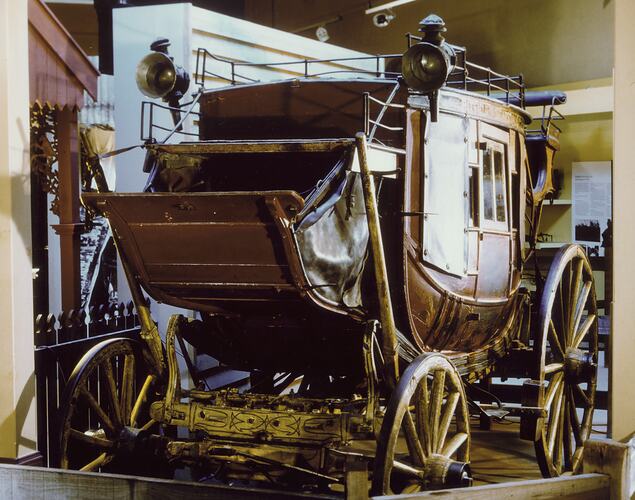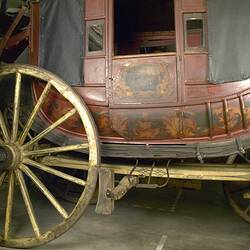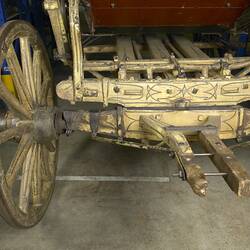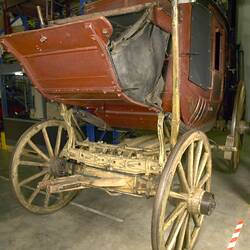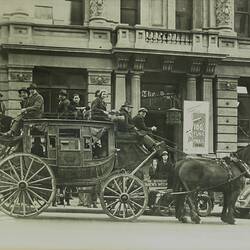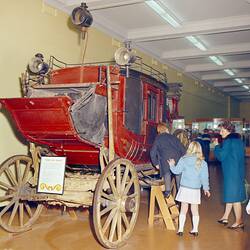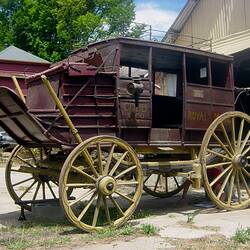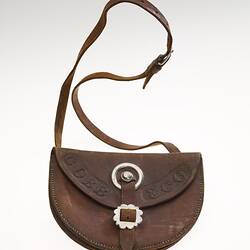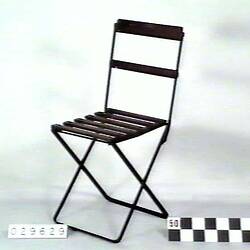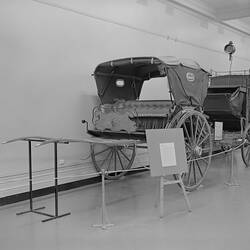Summary
Concord jack type thorough-brace coach built by Abbott & Downing, coachbuilders of Concord, New Hampshire, U.S.A., in the late 1860s. It was imported into Victoria by Francis Boardman Clapp. The coach has seating for the driver & 20 passengers (11 on the outside and 9 on inside seats). It was pulled by a team of four to eight horses, depending on loading. Donated to the Public Library (now State Library of Victoria) by the Aisbett family, who last used the coach on the Pitfield-Scarsdale route, southwest of Ballarat. The label 'PITFIELD - SCARSDALE' is painted in block lettering on the roof rails over each doorway. A previous owner's name, "McPhee & Co. Proprietors", is visible on the side boards of the driver's seat.
This coach is of the same type of vehicle that was introduced into Australia by Freeman Cobb and partners in the early 1850s, but it has no documented direct association with the original 'Cobb & Co' firm. F.B. Clapp acquired Cobb & Co's Melbourne-Ballarat route in December 1857 and by 1859 was one of Victoria's largest coach proprietors, having extended his services across much of south-west Victoria, to destinations such as Hamilton, Warrnambool, Portland and Penola. By 1867, Clapp had sold his coaching interests and was advertising himself as the 'Sole Agent' (in Victoria) for 'ABBOTT, DOWNING & COMPANY'S Coaches, Carriages and Buggies', with an office and showroom at 65 Little Collins Street, Melbourne.
By the 1860s the 'Cobb & Co' name was being used by numerous loosely associated but independent coaching firms operating throughout Victoria. Joshua Vines, a former Cobb & Co driver, purchased several of the F.B. Clapp & Co coach routes and later formed a partnership with John McPhee that continued to operate under the 'Cobb & Co' brandname until the early 1900s. After the opening of the branch railway line from Ballarat to Scarsdale in 1883, Vines & McPhee were awarded a Postal Department contract to run a twice daily 34 mile (55 km) mail coach service from Scarsdale to Skipton, via Linton, with a 15 mile (24 km) extension from Skipton to Streatham, further to the west. The route was sold to Pat Hogan in 1901 and continued to operate until March 1915, when it was replaced by a motor bus. The railway was meanwhile extended to Linton in 1890, and Skipton in January 1916.
Richard Aisbett was born in 1837, in the village of Thornley, County Durham, England, and arrived in Victoria during the latter part of the goldrush decade. He married Jane Irvine at Ballarat in 1862 and they settled at Scarsdale where he inititally followed his father, Edward, into the mining profession, before turning his hard to carting. His father was tragically killed in an underground mining accident in 1868, leaving Richard in part responsible for the welfare of a large extended family. In 1879 he established the Atlas Line of Coaches offering passenger services between the towns of Scarsdale, Newton and Ballarat, with additional routes to the outlying mining settlements of Kangaroo, Staffordshire Reef, Golden Lake, Piggoreet and Happy Valley to the south-west. In later years he operated a feeder service from Pitfield Plains and Berringa, meeting the train at Scarsdale or Newton Railway Stations, however, the direct service to Ballarat was also maintained in competition with the railway, at the fare of one shilling each way. Three of his sons, David Malcolm, Edward John and James worked for the business as coach drivers and by the 1900s were also involved in the management. After Richard's in 1911, they continued to operate the coaches under the name 'Aisbett Bros', until April 1916. Around 1899 or 1900, the Aisbett family bought several secondhand coaches from Vines & McPhee, including this original Abbott & Downing coach, according to a later account by James Aisbett. In 1925, the coach was bought to Melbourne by rail, to be displayed at the Motor Show in the Exhibition Building, and it returned again in August 1934 when it was donated to the Public Library and Museum on Swanston Street.
Physical Description
Wooden panelled body painted dark red with a cream undercarriage, wheels and brake levers with black line work. The roof and side roof rails are painted black. Externally there are four transverse bench seats - at the front the driver's seat, with a passenger seat behind it on the leading edge of the roof; and at the rear, two bench seats in a 'vis-à-vis' arrangement with the forward one on the rear edge of the roof facing backwards and a counterhung rear seat facing forward over the rear luggage rack. Around the edge of the roof is a low iron railing for securing additonal luggage and the passengers sitting on the two roof seats. Inside are three upholstered transverse bench seats with the front and rear seats in a 'vis-à-vis' arrangement facing the centre doorways, and a smaller folding 'dickey' seat across the centre. The body is supported by two large 'thoroughbrace' straps made of multiple loops of thick leather belting, suspended from elevated iron 'jacks' or standing brackets attached to the front and rear undercarriage cross beams. The vehicle has 12-spoked front and 14-spoked rear wheels with tappered plain journal hubs, iron tyres and iron hub bands. On each side of the driver's seat is a large foot-operated brake lever acting on single rear wheel brake blocks acting on the leading edge. The vehicle has three large removable single-candle headlamps mounted in brackets in the front centre and on left and right hand sides of the body immediately behind the driver's seat. The rear slatted wooden luggage rack and front driver's footboard are suspended from the body by leather straps and enlosed by triangular leather curtains to form front and rear 'luggage boots'. A faded vignette is painted on each door depciting a rural scene with a church and spire, three-arch stone bridge and river or lake on which there is a person in a small rowing boat. Below the vignettes and on the for and aft lower body panels are the faded remains of gilt ornate scrollwork. This artwork is believed to all date from the vehicle's original manufacture.
More Information
-
Collecting Areas
-
Acquisition Information
Donation & Subsequent Transfer from State Library of Victoria (SLV), E. J. Aisbett, 27 Jun 1935
-
Maker
Abbott & Downing, Concord, New Hampshire, United States of America, circa 1869
-
Importer
Mr Francis Broadmann Clapp, Melbourne, Greater Melbourne, Victoria, Australia, circa 1869
-
Inscriptions
The words 'PITFIELD - SCARSDALE' are painted in block lettering on the roof rails over each doorway. On the leather lining on the inside of each door is stencilled 'AISBETT BROS, PROPRIETORS, NEWTON'. A serial number is stamped on the end of each axle, and although obscured by hammering, appears to read "688" or "687", but is thought to be upside down and should actually be "289", as recorded in the Abbott & Downing order books as one of six coaches supplied to F.B. Clapp of Melbourne, in 1869.
-
Brand Names
-
Classification
-
Category
-
Discipline
-
Type of item
-
Overall Dimensions
4300 mm (Length), 2100 mm (Width), 3330 mm (Height), 800 kg (Weight)
Above dimensions are for overall height with centre headlamp in place. Height without centre lamp on vehicle (as shown in photo) is 2500 mm.
-
Keywords
